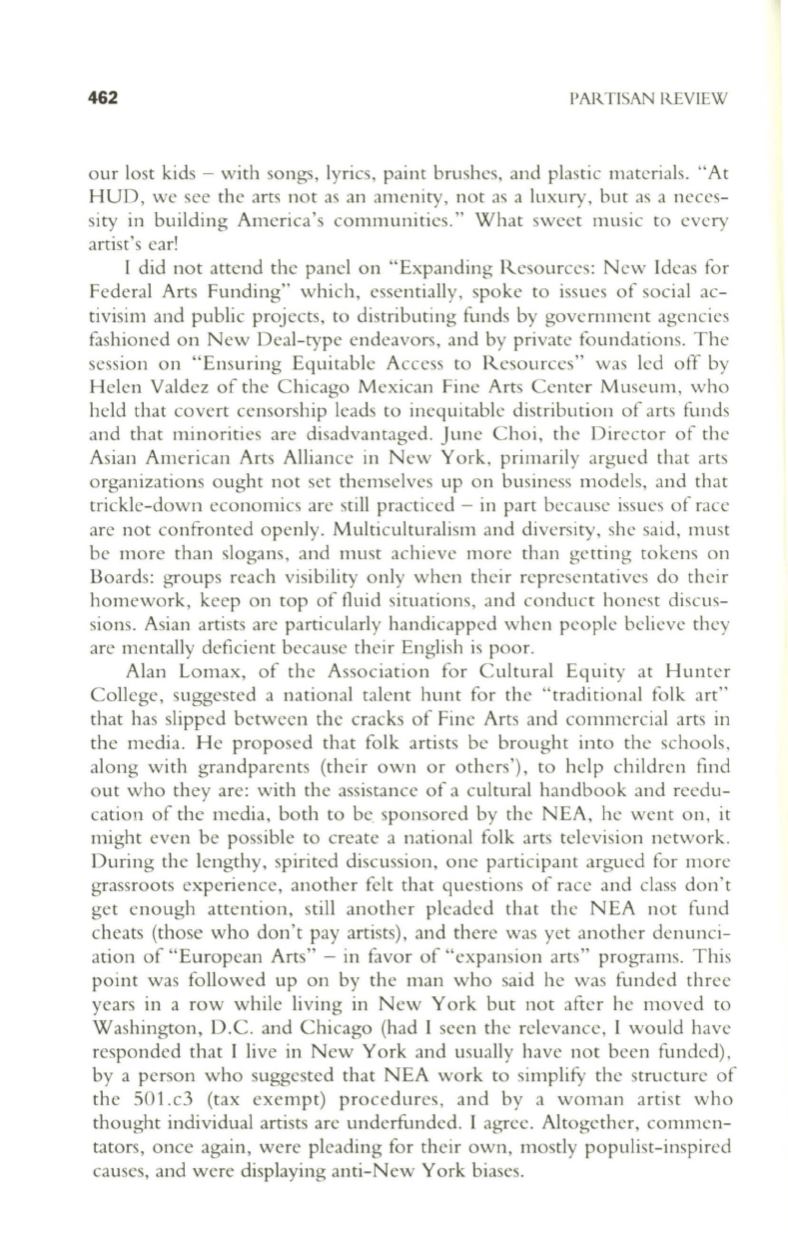
462
PARTISAN REVIEW
our lost kids - with songs, lyrics, paint brushes, and plastic materials. "At
HUD, we see the arts not as an amenity, not as a luxury, but as a neces–
sity in building America's communities ." What sweet music to every
artist's ear!
I did not attend the panel on "Expanding Resources: New Ideas for
Federal Arts Funding" which, essentially, spoke to issues of social ac–
tivisim and public projects, to distributing funds by government agencies
fashioned on New Deal-type endeavors, and by private foundations . The
session on "Ensuring Equitable Access to Resources" was led off by
Helen Valdez of the Chicago Mexican Fine Arts Center Museum, who
held that covert censorship leads to inequitable distribution of arts funds
and that minorities are disadvantaged. June Choi, the Director of the
Asian American Arts Alliance in New York, primarily argued that arts
organizations ought not set themselves up on business models, and that
trickle-down economics are still practiced - in part because issues of race
are not confronted openly. Multiculturalism and diversity, she said, must
be more than slogans, and must achieve more than getting tokens on
Boards: groups reach visibility only when their representatives do their
homework, keep on top of fluid situations, and conduct honest discus–
sions. Asian artists are particularly handicapped when people believe they
are mentally deficient because their English is poor.
Alan Lomax, of the Association for Cultural Equity at Hunter
College, suggested a national talent hunt for the "traditional folk art"
that has slipped between the cracks of Fine Arts and commercial arts in
the media. He proposed that folk artists be brought into the schools,
along with grandparents (their own or others'), to help children find
out who they are: with the assistance of a cultural handbook and reedu–
cation of the media, both to be, sponsored by the NEA, he went on, it
might even be possible to create a national folk arts television network.
During the lengthy, spirited discussion, one participant argued for more
grassroots experience, another felt that questions of race and class don't
get enough attention, still another pleaded that the NEA not fund
cheats (those who don't pay artists), and there was yet another denunci–
ation of "European Arts" - in favor of "expansion arts" programs. This
point was followed up on by the man who said he was funded three
years in a row while living in New York but not after he moved to
Washington, D.C. and Chicago (had I seen the relevance, I would have
responded that I live in New York and usually have not been funded),
by a person who suggested that NEA work to simplify the structure of
the S01.c3 (tax exempt) procedures, and by a woman artist who
thought individual artists are underfunded. I agree. Altogether, commen–
tators, once again, were pleading for their own, mostly populist-inspired
causes, and were displaying anti-New York biases.


